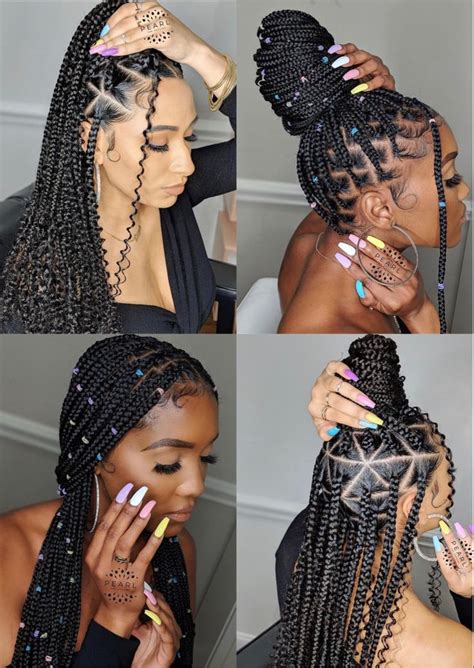Introduction
Protective hairstyles are essential for maintaining healthy hair, especially for individuals with textured hair. Among the most popular protective styles are knotless braids and box braids. Both offer unique benefits and drawbacks, making it crucial to understand the differences before deciding.

Knotless Braids vs. Box Braids: How Do They Differ?
1. Installation Method
- Knotless braids: Utilize the “feed-in” technique, where hair extensions are gradually added to the natural hair without tying knots at the root. This method results in a more lightweight and flexible style.
- Box braids: Created by dividing the hair into square sections and braiding the natural hair with extensions using the “underhand” technique, resulting in a tight and boxy appearance.
2. Appearance
- Knotless braids: Blend seamlessly with natural hair, creating a more natural and subtle look.
- Box braids: Stand out as a statement style due to their sharp edges and uniform size.
3. Size and Weight
- Knotless braids: Generally smaller in size and lighter in weight, making them ideal for medium to thick hair.
- Box braids: Can be customized to various sizes, ranging from small to jumbo, and are suitable for thick and dense hair.
4. Maintenance
- Knotless braids: Require regular moisturizing and sealing to prevent dryness. Maintenance can be easier due to the absence of knots at the root.
- Box braids: Need constant attention to keep the roots tangle-free and prevent frizz. The tight braiding method can make maintenance challenging.
Benefits of Knotless Braids
- Comfort: The absence of knots provides a more comfortable experience compared to box braids.
- Hair Health: The lack of tension at the root promotes hair growth and reduces breakage.
- Versatility: Can be customized into various styles, including updos, buns, and ponytails.
- Longevity: Lasts longer than box braids due to the absence of knots, which are prone to unraveling.
Benefits of Box Braids
- Durability: Known for their sturdiness and ability to withstand wear and tear.
- Variety: Offer endless customization options in terms of size, length, and color.
- Statement Style: Create a bold and eye-catching look that makes a statement.
- Scalp Protection: The tight braiding covers the scalp, providing protection from sun damage and environmental pollutants.
Cons of Knotless Braids
- Time-Consuming Installation: The feed-in method takes longer to install compared to box braids.
- Limited Size: Not suitable for individuals with fine or thin hair as they may not provide enough support.
- Moisturizing Needs: Require regular moisturizing to prevent dryness due to the lack of knots.
- Fraying: The ends of the braids may fray over time, requiring frequent maintenance.
Cons of Box Braids
- Tension: The tight braiding method can put excessive tension on the roots, leading to hair damage.
- Maintenance: Frequent maintenance is essential to prevent tangling and frizz.
- Weight: Larger box braids can become heavy, causing discomfort and scalp strain.
- Restricted Hairstyles: The rigid structure limits styling options compared to knotless braids.
Who Should Choose Knotless Braids?
- Individuals with medium to thick hair
- Those looking for a comfortable and natural-looking style
- People who prioritize hair health and longevity
- Those who prefer maintenance that is less time-consuming
Who Should Choose Box Braids?
- Individuals with thick and dense hair
- Those who want a statement style
- People who are comfortable with the required maintenance
- Those who prefer durability and longevity over comfort
Conclusion
Both knotless braids and box braids offer distinct advantages and disadvantages. The ideal choice depends on individual preferences, hair type, and lifestyle. Knotless braids provide a more natural and comfortable option, while box braids offer versatility and durability. Understanding the differences between these styles empowers individuals to make informed decisions that align with their hair care goals and aesthetic desires.
